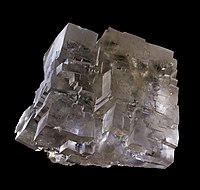
Photo from wikipedia
Abstract Nile tilapia has been cultured in a wide salinity range, from freshwater to up to 15 ppt brackish water due to its euryhaline characteristics. As salinity profoundly affects the physiology… Click to show full abstract
Abstract Nile tilapia has been cultured in a wide salinity range, from freshwater to up to 15 ppt brackish water due to its euryhaline characteristics. As salinity profoundly affects the physiology of freshwater and seawater fish in a different way, it is conceivable that pharmacokinetic (PK) behavior should also exhibit salinity-dependency. The current study aimed to investigate the effect of salinity on PK of florfenicol (FF) in Nile tilapia reared at 0, 2, 4, 8, and 15 ppt after a single intravenous (IV) or oral (PO) administration of 15 mg/kg at 28 °C. The implication of salinity-dependent PK in the optimal dosing regimen determination was also examined. The serum concentrations of FF were analyzed by HPLC-UV method and PK parameters were determined by the 2-compartmental model. Following IV injection, increasing water salinity from 2 to 15 ppt lead to a shorter elimination half-life (t1/2β) from 11.22 to 9.03 h, faster drug clearance (CL) from 0.047 to 0.056 L/kg/h, and smaller area under the serum concentration-time curve (AUC) from 326.19 to 267.74 h·μg/mL, suggesting a more rapid elimination at a higher salinity level. The results from PO study were generally consistent with the IV experiment except for the unchanged AUC over a salinity range of 0 to 15 ppt likely due to greater bioavailability at higher salinity. However, the absorption rate of FF was not significantly influenced by salinity as there were no significant differences in t1/2Ka, Cmax, and Tmax among the 5 salinity levels. The optimal dosing regimens were determined by the pharmacokinetic-pharmacodynamic approach for each salinity level and it was revealed that the calculated dosages were similar between 0 and 8 ppt salinity, but a higher dosage was required at 15 ppt (from 7 to 10 mg/kg/day at the MIC of 2 μg/mL). Therefore, Nile tilapia reared at saltwater required a higher FF dosage than those cultured at freshwater.
Journal Title: Aquaculture
Year Published: 2020
Link to full text (if available)
Share on Social Media: Sign Up to like & get
recommendations!